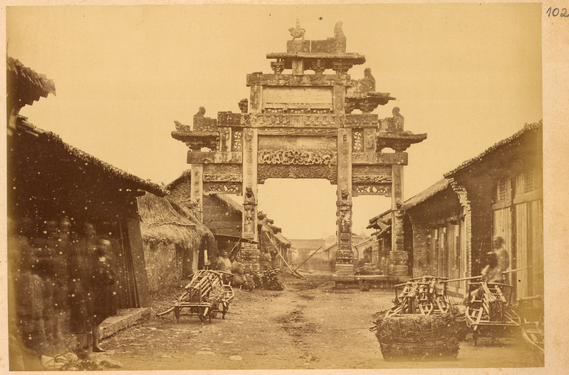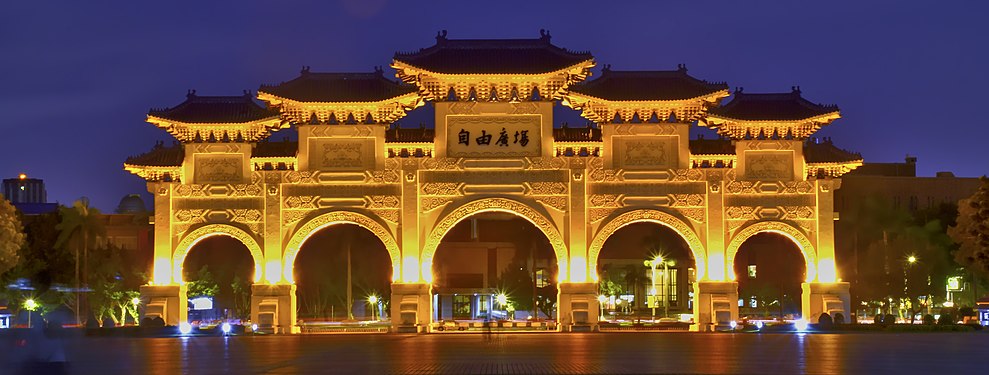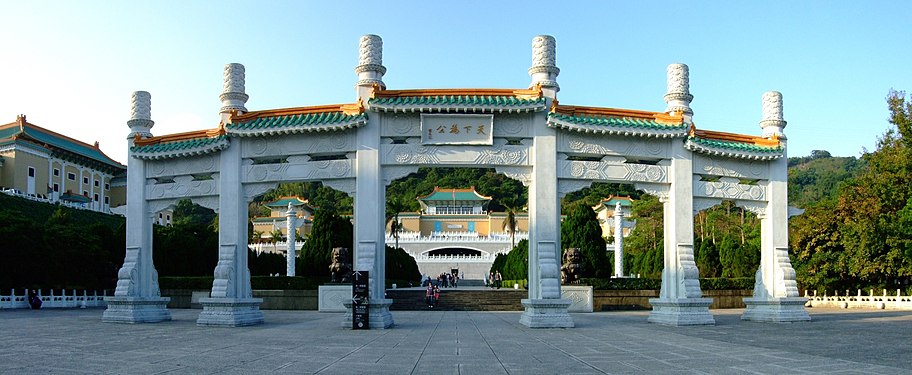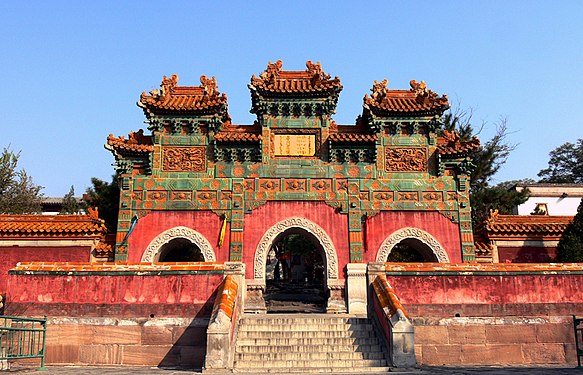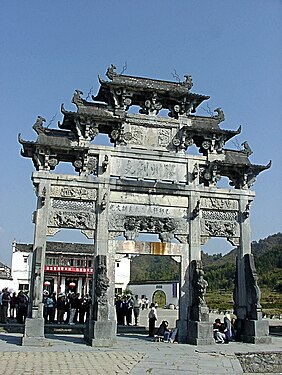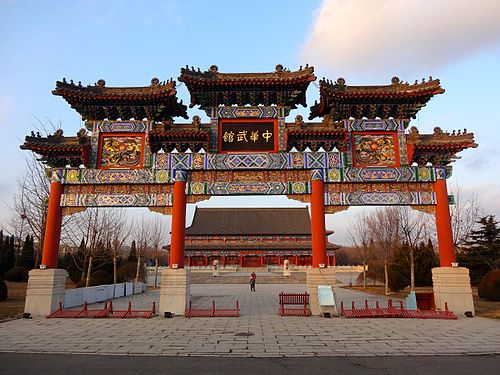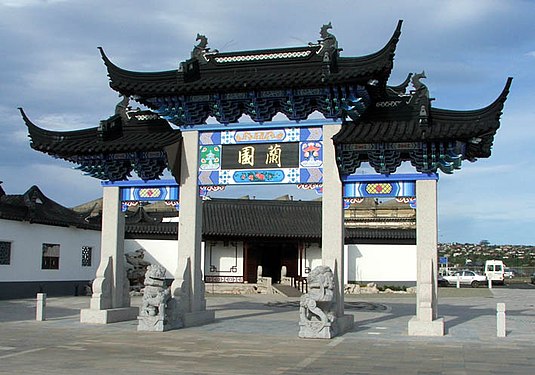Paifang
| Paifang | |||||||||||||||||||||||||||
|---|---|---|---|---|---|---|---|---|---|---|---|---|---|---|---|---|---|---|---|---|---|---|---|---|---|---|---|
 Paifang inShunfengshan ParkinFoshan | |||||||||||||||||||||||||||
| Chinese | Bài phường | ||||||||||||||||||||||||||
| Literal meaning | memorial archway gate | ||||||||||||||||||||||||||
| |||||||||||||||||||||||||||
| Pailou | |||||||||||||||||||||||||||
| Simplified Chinese | Bài lâu | ||||||||||||||||||||||||||
| Traditional Chinese | Bài lâu | ||||||||||||||||||||||||||
| Literal meaning | memorial archway edifice | ||||||||||||||||||||||||||
| |||||||||||||||||||||||||||

Apaifang,also known as apailou,is a traditional style ofChinese architecture,often used inarchor gateway structures.
Etymology
[edit]The wordpaifang(Chinese:Bài phường;pinyin:páifāng) was originally a collective term for the top two levels of administrative division and subdivisions of ancient Chinese cities. The largest division within a city in ancient China was afang(Phường;fāng), equivalent to a current dayward.[1]Eachfangwas enclosed by walls or fences, and the gates of these enclosures were shut and guarded every night. Eachfangwas further divided into severalpai(Bài;pái;'placard'), which is equivalent to a current day (unincorporated) community. Eachpai,in turn, contained an area including severalhutongs(alleyways).
This system of urban administrative division and subdivision reached an elaborate level during theTang dynasty,and continued in the following dynasties. For example, during theMing dynasty,Beijingwas divided into a total of 36 fangs. Originally, the wordpaifangreferred to the gate of a fang and the marker for an entrance of a building complex or a town; but by theSong dynasty,a paifang had evolved into a purely decorative monument.
History
[edit]During the Tang dynasty, it was called awutoumen(Ô đầu môn;wūtóumén;'black top gate'), because the top of the two posts were painted black. Awutoumenwas reserved for officials ofrank 6or higher.
The construction of wutomen was standardized in theYingzao Fashiof the midSong dynasty.[2]It consisted of two posts and a horizontal beam forming a frame and two doors. By the Ming andQingdynasties, it was called apailouorpaifang,and evolved into a more elaborate structure with more posts and gates, with a superstructural gable on top; the highest rank was a five gate-six post-eleven gable pailou.
It has been theorized that the paifang gate architecture was influenced byBuddhisttoranatemple gates.[3][4]Paifang have traditional Chinese architectural characteristics such as multi-tiered roofs, various supporting posts, and archway-shapes of traditional gates and towers.[5][6]
Style
[edit]Paifangcome in a number of forms. One form involves placing wooden pillars onto stone bases, which are bound together with wooden beams. This type ofpaifangis always beautifully decorated, with the pillars usually painted in red, the beams decorated with intricate designs andChinese calligraphy,and the roof covered with coloured tiles, complete with mythical beasts—just like a Chinese palace. Another form ofpaifangis in the form of true archways made of stone or bricks; the walls may be painted, or decorated with coloured tiles; the top of the archways is decorated like their wooden counterparts. Yet another form ofpaifang,built mainly on religious and burial grounds, consists of plain white stone pillars and beams, with neither roof tiles nor any coloured decoration, but feature elaborate carvings created by mastermasons.Another form is in the Han dynasty style, and is two matching towers, such as in Beihai.
Outside ofChina,thepaifanghas long been the symbol ofChinatowns.The largest outside of China is in the United States:Friendship Archwayat 14.50 m (47 ft 7 in) tall and 23 m (75 ft) wide, completed in 1986 at H and 7th inWashington D.C.'s Chinatown.[7]In Europe, the largestpaifangspans Nelson Street inLiverpool,completed in 2000 and standing 13.5 m (44 ft) tall.[8]The first paifang in the United States was raised in 1915 as a temporary installation for the Chinese pavilion of thePanama–Pacific International Expositionin San Francisco,[9]and the oldest still standing was erected in 1938 forLos Angeles,Chinatown West Gateon Hill Street;[10]it was listed as a city Historic-Cultural Monument (#825) along with its counterpart,Chinatown East Gate(1939, #826) in November 2005.[11]Thepaifangat the entrance toOttawa'sChinatownwas decorated by Chinese artists using Chinese materials and techniques.[12]
In the past,"ChastityPaifang"were given towidowswho remained unmarried tilldeath,praising what was seen as loyalty to their deceased husbands.[citation needed]
Gallery
[edit]Chinese-style paifang
[edit]-
Ornamental gateway (pailou) from theHan dynasty(202 BCE – 220 CE) across a street lined with small shops.Hanzhong,Shaanxi Province,China (1875).
-
Apaifangphotographed inGansu Province(1933).
-
PaifangofWuhan University(1920).
-
Paifangat theCemetery of Confucius,tomb of Lady Yu, wife of Kong Xianpei (72nd generation) inQufu,China.
-
Decoratedpaifangat theSummer Palacein Beijing.
-
Colour glaze gateway at Puotuo Zongcheng temple,Chengde.
-
PaifanginXidi.
-
Pailouat the entrance toQiandao LakeScenic Area.
-
Paifangsat the entrance toYonghe Temple,Beijing,China.
-
Paifangat the entrance toChinatown in Boston, Massachusetts.
-
PailouatDunedin Chinese Garden,New Zealand.
See also
[edit]- Chinatown gate
- Shanmen,gate of Chinese Buddhist temple
- Hongsalmun,in Korean architecture with both religious and other usage
- Iljumun,portal in Korean Buddhist temple architecture
- Tam quan,a Vietnamese Buddhist style of traditional gateway
- Trụ biểu,in Vietnamese temple architecture
- Torana,a Hindu-Buddhist ceremonial arched gateway
- Torii,in Japanese Shinto shrine architecture
References
[edit]- ^Steinhardt, Nancy Shatzman (2019).Chinese Architecture: A History.Princeton University Press. p. 729.ISBN9780691191973.
- ^Li Jie."The Construction of Wutoumen".Yingzao FashiDoanh tạo pháp thức.Vol. 6: Minor Woodwork I.
- ^Albert Henry Longhurst(1936).The Story of the Stūpa.Asian Educational Services. p. 17.ISBN978-81-206-0160-4.
- ^Joseph Needham, Science and Civilization in China, Vol 4 part 3, p137-138
- ^Ronald G. Knapp (2000).China's old dwellings.University of Hawaii Press.p. 85.ISBN0-8248-2214-5.
- ^Simon Foster; Jen Lin-Liu; Sharon Owyang; Sherisse Pham; Beth Reiber; Lee Wing-sze (2010).Frommer's China.Frommers.p. 435.ISBN978-0-470-52658-3.
- ^"Friendship Archway, (sculpture)".Smithsonian Institution Research Information System.Retrieved18 February2011.
- ^"Liverpool's Chinese arch ten years standing".BBC.19 February 2010.Retrieved18 February2011.
- ^Allen-Kim, Erica (Spring 2013)."The Political Economy of Chinatown Gates".Pidgin.No. 15. Princeton University School of Architecture.Retrieved29 April2020.
- ^Exploring Chinatown: Past and Present(PDF)(Report). Los Angeles Conservancy.Retrieved29 April2020.
- ^Historic-Cultural Monument (HCM) List(PDF)(Report). Department of City Planning, City of Los Angeles. April 21, 2020.Retrieved29 April2020.
- ^"Ottawa's Chinatown Celebrates Completion of New Gateway".Government of Canada. October 7, 2010.RetrievedMay 21,2022.
Construction of the arch included a team of technicians from China, as well as a group of artists who used traditional Chinese painting techniques to enhance the many ornate elements of the design. Glazed golden tiles, donated by China, adorn the nine roofs of the structure.
External links
[edit] Media related toPaifangat Wikimedia Commons
Media related toPaifangat Wikimedia Commons

